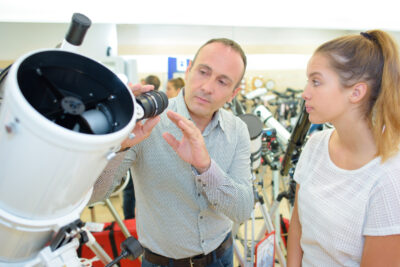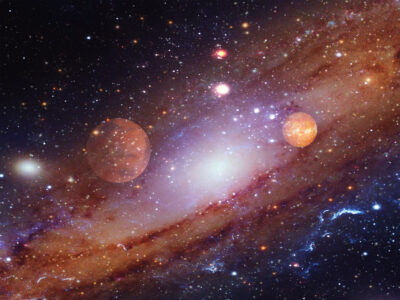James Webb Space Telescope is the name of an enormous space telescope that will soon be launched into space. Like the Hubble, it will reside in outer space. Unlike the Hubble, it will have new 21st-century instrumentality.
Soon, the James Webb Space Telescope will be shot into orbit. In fact, if the weather cooperates, it will happen in less than 2 months. Experts are setting their sights on December 18.
Big News in the Optics Industry: The James Webb Space Telescope

Telescopes Fascinate People of All Ages. But, the New James Webb Space Telescope is the Greatest of Them All.
At ER Precision Optical, we don’t think building a mammoth telescope is easy. However, building it, and then launching it into outer space is simply phenomenal. It certainly is news in the world of optics. Thus, last week we blogged about seeing tiny things up close and large with microscopes. Now it is ironic that we will blog about the scope we use to see giant, far away things. Only now, we see them close up with the telescope.
A Technology Tour: The Instruments of the James Webb Space Telescope
The James Webb Space Telescope will travel its orbit with a “crew” of four major scientific instruments. Thus, the telescope will empower us with “observations in visible, near-infrared and mid-infrared (0.6 to 28.5 micrometers) wavelengths.”
1. Meet the Near-Infrared Camera (NIRCam)
The University of Arizona contributed the NIRCam. It is an infrared camera built to detect light from stars both in the Milky Way and other nearby galaxies.
“It will also search for light from stars and galaxies that formed early in the universe’s life. NIRCam will be outfitted with coronagraphs that can block a bright object’s light. This will make dimmer objects near those stars (like planets) visible.”
2. Onboard We Also Have a Near-Infrared Spectrograph (NIRSpec)
NIRSpec knows the night has many eyes. It “will observe 100 objects simultaneously…” Additionally, it will also be on a search for the “first galaxies that formed after the “Big Bang.” The European Space Agency created the NIRSpec Technology, with help from NASA.
3. For Astro-photographic Art: Meet MIRI, Traveling Within the Telescope.
Mid-Infrared Instrument (MIRI) will photograph far distant galaxies and stars. Likewise, MIRI’s images will give us more details about how stars are formed. “MIRI was built by the European Consortium with the European Space Agency and NASA’s Jet Propulsion Laboratory.”
4. Equally Important: Fine Guidance Sensor/Near InfraRed Imager and Slitless Spectrograph (FGS/NIRISS):
Also lodged in the James Webb Space Telescope, this Canadian Space Agency-built instrument has 2 parts.
- The FGS component maintains the James Web Space Telescope in the proper orientation while it performs its exploration.
- Meanwhile, the NIRISS hunts for the first light, the oldest light, in the Universe.
More Fantastic Facts about the new James Webb Space

NASA Has Provided Us With Images Like These. Science and Art Blend Such Celestial Photographs. However, We Cannot Imagine What Else the Next Telescope Will Capture.
The Telescope sports a sun shield “the size of a tennis court.” That is so large that it cannot travel while it is open. Therefore, it will unpack itself and unfurl once it has arrived at its designated point in space.
Like all telescopes, the James Webb must have a mirror. Thus, the international team will be launching the largest mirror ever created for space travel. It measures 21.3-foot (6.5 meters.) The ESA stated it created the mirror from beryllium, for lightness and strength.
Additionally, they covered it “in a microscopically thin layer of gold to aid the reflection of infrared light.”
Mirror, Mirror: Hexagons Create a Monster Mirror
What folds like butterfly wings and unfurls like a drop-leaf table? The James Web Space Telescope mirror, of course!
According to NASA, “The Webb Telescope team also decided to build the mirror in segments on a structure which folds up…” This was wise engineering since it is about the only way to stow it in the rocket.
The mirror works “like the leaves of a drop-leaf table so that it can fit into a rocket. The mirror would then unfold after launch.”
If you could see it, you would note “Each of the 18 hexagonal-shaped mirror segments is 1.32 meters (4.3 feet) in diameter, flat to flat.”
The images of building this structure amaze anyone who is interested in science and technology. We highly recommend you look at them at this reliable online resource.
James Webb Space Telescope Complements the Hubble Space Telescope
Scientists created the James Webb Telescope because of the knowledge sent to us by the famed Hubble telescope. They will complement each other, rather than compete.
“Scientific advancement is all about “standing on the shoulders of giants.” And the JWST will do just that. The results from Hubble motivated the scientific goals. Find out more ways these super-telescopes compare and contrast by visiting this amazing online resource: Comparison: Webb vs Hubble Telescope – Webb/NASA
The Space Telescope: The Operation and the Mission

Because of the New Space Technology, Today’s Children Might Grow Up With a New Understanding of Our Universe.
The scope of the James Webb Space Telescope is much too large to cover in just this one blog. Therefore, we will continue our discussion next week in Part II. We will explore the mystery of the “Redshifted” light. Additionally, we will compare our newest space telescope with the Hubble telescope in terms of:
- How each telescope sees.
- The mission and goals.
Additionally, we answer such questions as:
- What is STTARS?
- Where is the telescope now?
- And the next steps?
Until then, we at E.R. Precision Optical thank you for reading our blog. And we hope you will return for what we believe is a fascinating and long-awaited space story from the world of optics.


